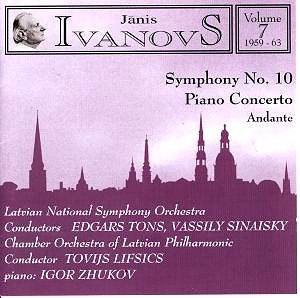Campion must surely rate an industry award for their
dogged pursuit of the Ivanovs radio tapes from Latvian Radio. With each
disc issued there will have been a complex of copyright issues to surmount.
Each issue is achieved against the tide. The company have already issued
volumes 1-3. Contractual issues have caused them (for now) to skip over
instalments 4 and 5 and move directly to volumes 6 and 7.
Ivanovs is a Latvian late-romantic with an idiom that
developed closer to mid-period Prokofiev with subtle elements of 19th
century Nordic romance (Sibelius and Atterberg) and also of modernity
(Honegger and Shostakovich).
There can be little doubt that Janis Ivanovs' ambition
was as a symphonist. After all he wrote twenty-one of them from the
1930s through to the 1970s. The symphonic creative urge remained vital
throughout his mature life. His productivity was much more evenly spread
that that of a Havergal Brian a composer with whom, at least quantitatively,
he can be compared. The majority of Brian's thirty-two symphonies belong
to his seventies, eighties and nineties. Brian held a place of honour
in Malcolm Macdonald's seminal book on 'musical mavericks', "Opus Est"
(Kahn and Averill, 1978). Ivanovs could so easily have been found alongside
Mr Macdonald's pantheon which included Pettersson, Brian, Vermeulen
and Sorabji.
The half hour long Piano Concerto is tougher,
less overtly proletarian than Ivanovs' wonderfully lyrical Violin Concerto.
It has a hieratic or incantatory tone - touched with the monumentalism
of Bax's Symphonic Variations, the splintery oratory of Ireland's
Piano Concerto and the asperity of Prokofiev as in the up-rushing introduction
of the Prokofiev First Piano Concerto. At the start of the andante
moderato (II) the influence is early Rachmaninov and Scriabin (the
piano concerto). Zhukov, a Russian trained by Heinrich Neuhaus in Moscow,
was a friend of Ivanovs. He revels in the sometimes splenetic demagoguery
as well as the reticent poetry. Ivanovs is said to have applauded his
interpretation. The early interpreters of the concerto were Konstantins
Blumentals, Nikolajs Federovskis.
The Andante (track 4) is said
to be for 'cello ensemble'. This must be a mistake. It sounds to me
like a full string orchestra. The movement is nothing short of a meditation
rather in the spirit of the Barber Adagio but with a theme rather
like the slowly rocking epilogue-dream of Bax's Third Symphony or the
central episode of the same composer's Summer Music. The 'meditation'
is interrupted by a more lively yet still earnest section with the hand
of Shostakovich firmly on Ivanovs' shoulder before a return to grey
Baltic introspection. This is in much the same genre as Sibelius's Rakastava.
The radio tape masters have suffered some tape damage although this
only impinges on the listener's pleasure towards the end of the piece.
The Tenth Symphony is in four movements launched
by a Dialogo (at just over ten minutes the longest), then a Toccata
Basso Ostinato, an Intermezzo and an Allegro Moderato.
Both the Dialogue and the Finale are raucous, anxious,
rushing and imitative of the pell-mell paranoia of the quicker sections
of an Allan Pettersson symphony. The Toccata is motoric and doom-filled
like a Khachaturian presto. The Intermezzo breathes in
long paragraphs - a cross between a string mesto by Roy Harris
(say from symphonies, 3, 6 or 7) and Martinu's Concerto for Double String
Orchestra, Piano and Timpani. This is a work strong on atmosphere but
it does not feel symphonically rounded.
You must not expect state of the art sound but this
is a small price to pay for the experience of hearing such rare and
often rewarding music. I am not quite sure what to make of the symphony
but both the Andante and the Concerto (Ivanovs' last of three
- the other two have already been issued by Campion) are works with
obvious attractions in terms of early 20th century neo-romanticism.
The liner notes are very full and in English and German.
They are plagued with typos. I hereby volunteer to check over the next
set of notes.
These are ADD recordings and I suspect that the
Tenth Symphony is in mono.
Rob Barnett
AVAILABILITY
www.dimusic.com
DETAILS OF THE FIRST SIX OF THE COMPLETE CAMPION IVANOVS SERIES
12 volumes
Issued May 1999
1 1933-36 Symphony No. 1; Symphony No. 2; Latgalian Landscapes Review
2 1938 Symphony No. 3; The Cloudy Mountain; Cello Concerto Review
Issued 1998
3 1939-41 Symphony No. 4; Rainbow Review
To be issued
Early and very fluid details are as follows:-
4
1945 Symphony No 5 43' 12"
1949 Symphony No. 6 33' 45" 76.57
5 1951 Violin Concerto 31' 20"
(same version as already released separately Review
- other version to be deleted)
1954 Symphony No 7 33' 47" 65' 07"
6
1955 Frost In Spring 20' 10"
1956 Symphony No 8 32' 47"
1957 Lacplesis 14' 11" 67' 08"
7
1959 Piano Concerto 25' 57"
1963 Andante 7' 34"
1963 Symphony No 10 31' 59" 65' 30"
8
1965 Symphony No 11 32' 55"
1966 Poema Luttuosa 12' 36"
1967 Symphony No 12 24' 08" 69' 39"
9
1969 Symphony No 13 33' 13"
???? Festival Overture 3' 57"
1971 Symphony No 14 21' 44" 58' 54"
10
1972 Symphony No 15 30' 19"
1974 Symphony No 16 30' 34" 60' 53"
11
1976 Symphony No 17 31' 40"
1977 Symphony No 18 33' 08" 64' 48"
12
1979 Symphony No 19 38' 27"
1981 Symphony No 20 26' 41" 64' 08"
"SUPPLEMENTARY CD 1"
1983 Symphony No 21 (completed by ??) 23' 13"
1940* The Solemn Prelude 4' 32" (*already out of order)
Date unknown Symphonietta 11' 53"
Possible new recording by now of 9th Symphony 32' 00" approx.
74' 00" or less
Violin Concerto already available differently coupled with Sibelius
and Sallinen concertos on a Campion disc
Orders and enquiries can be made to DIMus@aol.com


